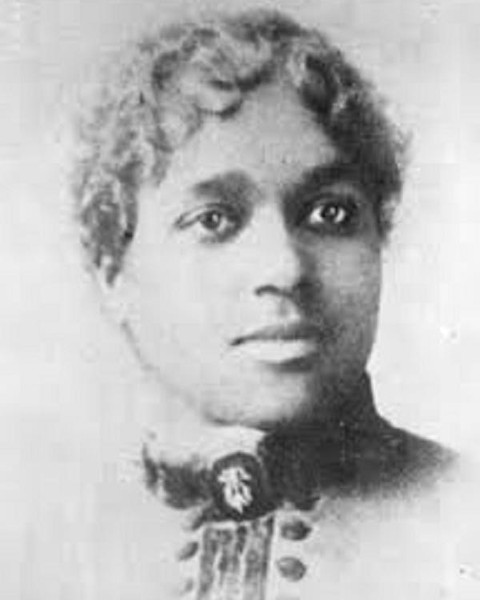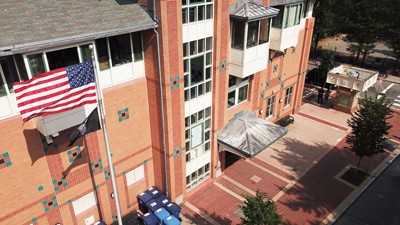Maria L. Baldwin School
Introduction
Text-to-speech Audio
Maria Louise Baldwin (1856-1922) was an educator and civic leader from Cambridge, MA. Baldwin spent 41 years as a teacher, principal, and schoolmaster at the Agassiz Grammar School. In 2002, the school was re-named the Maria L. Baldwin School. The Maria L. Baldwin School was founded in 1875 in a two-story brick building. By the second year, the school expanded to meet a growing student population. (See also the entry “Maria L. Baldwin House.”)
Images
Maria Baldwin

The Baldwin School Today

Backstory and Context
Text-to-speech Audio
Maria Baldwin was born in 1856 in Cambridge and educated in Cambridge public schools. In 1875, she graduated from the Cambridge training school for teachers. Because Cambridge schools refused to hire Black teachers, after Baldwin graduated, she began working in a segregated school in Chestertown, Maryland. In 1880, she returned to Cambridge after her father’s death and began looking for work there to support her family. In 1881, she was offered a full-time teaching position at the Agassiz School (now the Maria L. Baldwin School). Her hiring was due in large part to pressure from Black community members, many of whom had already been pressing the Cambridge public schools to hire qualified Black teachers.
In a profile of Baldwin written by Pauline Hopkins (another woman on our walking tour), Baldwin says that she was resistant to being appointed principal. She wrote, “I am happier with the little children, and prefer to remain where I am. If I failed in the position you mention, it would be a conspicuous failure.”5 In 1899, after encouragement from trusted colleagues, Baldwin accepted the offer, becoming the first Black woman to be a school principal in the Northeast. In 1916, when the school expanded, she was made schoolmaster, the only woman in Cambridge and the only Black person in New England to have this position. W. E. B. Du Bois later described her as having achieved “the most distinguished position . . . in the teaching world in America” for any Black person in this period.4 As principal, she had authority over primarily white teachers and students who were often the children of Harvard professors and other elite figures in Cambridge. A member of the Cambridge School Board described her personality: “From the first day I saw her I realized she was a rare character . . . Her poise and dignity, her calmness and beautiful voice struck me at once, and I felt that her mere presence must be a valuable lesson to all the children. Several parents told me their children realized this and always spoke of her with admiration and affection.”3 As a teacher, Baldwin was remembered especially for her kindness and patience with children. One of her students was the future poet E. E. Cummings. In a letter Baldwin sent to Cummings’ mother, she demonstrated her personalized attention to students: “He is a most lovable little boy, and we are glad that he is a part of our little community.”6 She was also remembered for her innovation, such as introducing the first school nurse to serve in the Cambridge schools. She worked at the Agassiz School for forty-one years until her death in 1922.
The school in which Baldwin worked and the neighborhood in which she lived were both named after Louis Agassiz, a Harvard professor infamous for promoting scientific racism. In an effort led by parents and students to move away from the racist connotations of the original name, the Agassiz School was renamed the Maria L. Baldwin School in 2002. Nearly twenty years later, in August 2021, the neighborhood's name is now known as "The Baldwin Neighborhood," the name change approved in a 9-0 vote by city councilors. These efforts suggest that Cantabrigians (Cambridge residents) are challenging what is valued in local Cambridge history and questioning whose legacies are commemorated.
Sources
1. Solomons, Olivia. “Maria Louise Baldwin.” Negro History Bulletin 5, no. 1 (1941): 19-20.
2. “History of Baldwin School,” Cambridge Public Schools, https://baldwin.cpsd.us/cms/One.aspx?portalId=3043283&pageId=3579044 accessed 6 May 2021.
3. Porter, Dorothy. “Maria Louise Baldwin, 1856-1922.” The Journal of Negro Education 21, no. 1 (1952): 94.
4. Weiler, Kathleen. Maria Baldwin’s Worlds: A Story of Black New England and the Fight for Racial Justice, University of Massachusetts Press, 2019: 31-33.
5. Hopkins, Pauline. "Famous Women of the Negro Race VII: Educators." Colored American Magazine 5, no. 2 (June 1902): 127. http://coloredamerican.org/wp-content/uploads/2017/02/CAM_5.2_1902.06.NS_.pdf
6. Baldwin, Maria. Letter to Rebecca Haswell Clarke Cummings, 28 October 1904, Box 58, Folder 11, Houghton Library, Harvard University Libraries, Cambridge, MA, 7 May 2021.
7. Meek, Tom. “Support builds for ‘Baldwin Neighborhood,’ removing racist association of Agassiz name,” Cambridge Day, 16 January 2020, https://www.cambridgeday.com/2020/01/16/support-builds-for-a-baldwin-neighborhood-removing-racist-association-of-agassiz-name/, accessed 4 May 2021.
8. Levy, Mark. “Baldwin Neighborhood name is approved 9-0, replacing Agassiz; second such change since ’15,” Cambridge Day, 2 Aug. 2021, https://www.cambridgeday.com/2021/08/02/baldwin-neighborhood-name-is-approved-9-0-replacing-agassiz-second-such-change-since-15/, accessed 18 Sept 2021.
https://baldwin.cpsd.us/about_our_school
